Guerrilla Producers Explore The Balance Between Vine and Land in The Splendid Isolation of The Ardèche Region in Southeastern France – Eleven Wines From Four Vignerons ($379)
It is said that there are wines to be drunk sitting down and there are wines to be drunk standing up. The former category includes blockbusters whose names we proudly drop and whose price may at times outstrip quality but which still represent the mythos behind ‘bragging rights.’
The others, intentionally light, fresh and full of ‘joie de vivre’, are wines for conversations that do not necessarily revolve around the wine.
Located in the ‘gap’ between Northern and Southern Rhône, Ardèche is capable of generating both; it is generally an IGP region that also encompasses the famous appellations of Saint-Joseph and Cornas, and its 27,000 acres of vineyards (southwest of Montélimar, on the western banks of the Rhône river) is still considered somewhat terra incognita, even among the French.
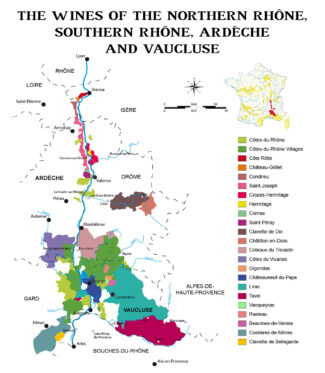
It is also home to some of the most innovative natural winemakers in France. The region’s warm Mediterranean climate, sprinkled with plenty of sunshine and gentle Mistral breezes and well-drained soils, creates the perfect environment for growing grapes with vibrant flavors and natural acidity—the key to producing wines without additives, wines that emphasize fruit and an almost electric energy that speaks immediacy.
The Ardèche: Where Land Is Unspoiled
The Ardèche exists (if at all) at the periphery of most overviews of French wine regions, even those written by the French. And yet, it has the climatic breeding to produce outstanding wines, and has been doing so for as long as the region has had a name.
In France, this is a rare combination of circumstances that allows young winemakers of vision to purchase vineyards land at reasonable rates. As a result, IGP-level vineyards found in the dry, scrubby foothills of the Cévennes mountains and along the river Ardèche valley are hosting more and more upstart wineries with farsighted plans and expectations.
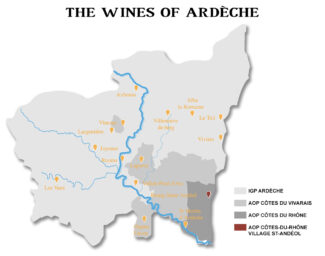
The Ardèche department is not exactly ‘frontier’. It lies 30 miles south of Lyon, about 60 miles north of the Mediterranean, with the Rhône river to the east and the Massif Central plateau to the west. Geographically, the region can be divided into the mountainous central west, the high plateaus of the Haut-Vivarais and the Cévennes in the center, the low-lying Bas-Vivarais plains of the Ardèche river in the south, the volcanic Coiron plateau to the east and the Rhône valley itself.
Fruit Happens Naturally
The delicate pas-de-deux between winemaker and wine merchant is as nuanced as the end product. At Elie’s, we accept that both parties are bound by certain obligations and subscribe to the paradigms inherent in all transactions: We look at wine as the stuff of liquid memory; a place-holder to look back upon as a highlight that enhances an unforgettable experience.
Wine is, of course, juice made from fruit. However obvious that sounds, cellar manipulations may sometimes override that basic concept. The edge seized by natural winemakers is a return to a reliance on the juice itself, fermented without adornment, bottled without artifice, in an attempt to allow the grape and blends to clearly articulate a voice and leave a fingerprint.
Before we stock any wine from a ‘natural’ winemaker, we do our due diligence to ensure that the winemaker has done her/his own; in other words, tended their vineyard according to any pledge made or certification earned, and then produced a product which may articulate over time—generally no more than a year or two—the winemaker’s precise intention.
For the most part, this is the expression of the fruit rather than the cellar, the splendors and stability of natural chemistry unsullied by flourishes.

La Vrille et Le Papillon
La Vrille et le Papillon, meaning ‘The Tendril and The Butterfly’, is located in Valvignères, perhaps the epicenter of the Ardèche natural wine scene. Proprietors Méryl and Géraldine Croizier also represent the very sort of winemakers our introduction lionizes—young, energetic folks ready to let their terroir sing fortississimo.

Géraldine and Méryl Croizier, La Vrille et Le Papillon
Méryl, with a degree in agriculture from Dijon and oenology from Montpellier, peppered his education with real-time experience learning winemaking from Gerald and Jocelyne Oustric at Domaine du Mazel, who have been ecological producers for over 20 years. The Oustrics have been instrumental in the growth and nurturing of new winemakers in the area, renting vines to Sylvain Bock and Andrea Calek.
With Géraldine, Méryl works 12 acres planted to Syrah, Merlot, Grenache, Cabernet Sauvignon, Viognier and Ugni Blanc on clay limestone soil. They converted everything to organic, avoiding herbicides and pesticides, and in 2014, with the completion of their cellar, have introduced tisanes (herbal soil enhancers) and biodynamic practices, relying on wild yeasts only and eschewing fining and filtration.
 La Vrille et Le Papillon ‘Le Bruit des Glaçons’, 2021 Ardèche VdF Rouge ($27)
La Vrille et Le Papillon ‘Le Bruit des Glaçons’, 2021 Ardèche VdF Rouge ($27)
‘The Sound of The Ice Cubes’ suggests a wine best consumed with a chill—the beverage, not the drinker. Don’t be tempted—this is a meaty 50/50 blend of Grenache and Syrah best served at cellar temperature. The name refers to the fact that the fruit survived the treacherous hailstorms in the spring of 2021. From the Valvignères sub-region of Ardèche, the wine offers big aromas of Bing cherries and macerated strawberries with notes of black pepper, bittersweet dark chocolate and spices—thyme, rosemary and paprika note—held in place by tangy acidity and silken tannins.
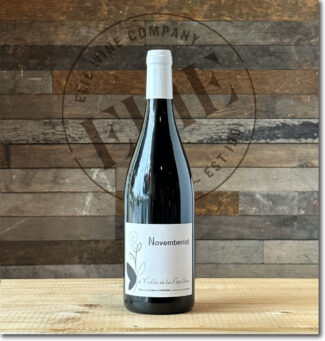 La Vrille et Le Papillon ‘Novemberlot’, nv Ardèche VdF Rouge ($29)
La Vrille et Le Papillon ‘Novemberlot’, nv Ardèche VdF Rouge ($29)
A strikingly unusual blend of 90% Merlot from the 2019 vintage and a 10% blend of Viognier, Ugni Blanc and Grenache Blanc harvested in November, 2021. Plum and cherry with a nice aromatic top note of flowers and citrus.
Sylvain Bock
So tight is the natural winemaking network in Ardèche that the same names keep reappearing. Sylvain Bock is one of them. Based in the pretty village of Alba-la-Romaine, he has been running his own domain since 2010, having previously worked for Gerald Oustric at Le Mazel, where Meryl Croizier also cut his teeth.

Sylvain Bock
Sylvain’s vineyards are spread over two sites: The first, nearest to his cellar, is composed mainly of limestone with very little topsoil and is planted with Chardonnay and Grenache Blanc as well as a few rows of old vine Grenache Noir and Merlot. Further north in the valley, at higher altitudes, he grows Gamay, Syrah and an additional plot of Grenache Noir planted on basalt.
“Our work in the cellar is minimal,” he says. “There are no additions of any kind. Technique simply involves fermenting most of the grapes on their stems with only the old vine Grenache—grapes good enough to go into ‘Neck Plus Ultra’—de-stemmed for a slower traditional maceration. It requires patience and knowledge to create wines of purity and freshness, without compromising on depth. I don’t want to make nouveau wines; let winter do its job. I release them when they are ready.”
 Sylvain Bock ‘Fruit Jazz’, 2022 Ardèche VdF Rouge ($28)
Sylvain Bock ‘Fruit Jazz’, 2022 Ardèche VdF Rouge ($28)
A new cuvée of 60% Grenache and 40% Syrah containing fruit that once went into Sylvain’s ‘Les Grelots’—‘Jingle bells.’ Sylvain himself describes the wine as ‘a Herbie Hancock keytar-solo in a bottle’ but we’ll stick with ‘a resonant red filled with rustic dried-blackberry and peppercorn compote accented with cocoa against nervy acidity and crushed velvet tannin.’
 Sylvain Bock ‘L’Equilibriste’, 2020 Ardèche VdF Blanc ($44)
Sylvain Bock ‘L’Equilibriste’, 2020 Ardèche VdF Blanc ($44)
Literally, an ‘équilibriste’ is a tightrope walker; in a bottle, it is a selection of Sylvain’s barrels of Chardonnay deemed suitable for extended aging. Directly pressed, fermented and aged in barrel for two years, this results in an opulent and serious white. The high limestone content of Sylvain’s Saint Philippe vineyard lends a bright acidic backbone to the wine, making it suitable for the long haul as well as this evening.
Les Bois Perdus
The path from an IMDb profile to the rural wilds of Aubignas in the Ardèche may seem an unlikely one, but to Léna Perdu and Alexis Robin, the call of the wine won the day. The pair of film industry expats decided to leave Tinseltown for terroir, settling on five acres of vines among the cliffs and gorges and enchanted forests of Ardèche. Translated literally, Les Bois Perdus means ‘The Lost Woods.’

Alexis Robin, Les Bois Perdus
Léna says, “Our project is part of a family approach to working our land and making a product that is respectful of its origins. After having spent ten years in the world of cinema, Alexis and I were ready for a new adventure, and we chose to answer the call of ‘la terre et ses nectars’ (the earth and its nectars) against all odds. We therefore chose to make a natural, harmonious and rich wine with Ardèche beauty. Our vintages carry within them all the sincerity and intensity that have accompanied us since this new beginning.”
 Les Bois Perdus ‘Elle Tremble’, 2021 Ardèche VdF Rouge ($29)
Les Bois Perdus ‘Elle Tremble’, 2021 Ardèche VdF Rouge ($29)
‘She Trembles’ (but in a sensuous way): 100% Merlot grown on schist in Sallèles. Half destemmed and half direct-pressed, the juice undergoes ten days of maceration followed by vinification and élevage in stainless-steel. A fruit-centered blockbuster with black currants, Damson plums and blackberries predominant.
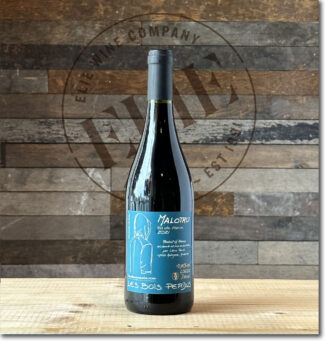 Les Bois Perdus ‘Malotru’, 2021 Ardèche VdF Rouge ($31)
Les Bois Perdus ‘Malotru’, 2021 Ardèche VdF Rouge ($31)
‘Malotru’ means ‘brute’, so you be the judge: 80% Carignan, 10% Syrah and 10% Grenache grown on clay-limestone soils in Saint Hilaire d’Ozeilhan. The Carignan undergoes 15-day semi-carbonic maceration, with the addition of the direct-pressed juice of Syrah and Grenache over the final five days. Vinification and élevage take place in stainless-steel. The wine emphasizes Carignan’s splendid aromatics, with the more prestigious junior partners bringing dark-berry flavors with a savory and smoky twist.
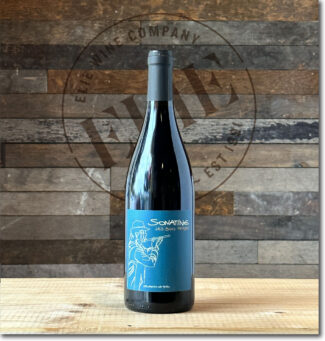 Les Bois Perdus ‘Sontaine’, 2021 Ardèche VdF Rouge ($34)
Les Bois Perdus ‘Sontaine’, 2021 Ardèche VdF Rouge ($34)
100% Gamay grown on basalt, limestone and shale in Aubignas, with maceration ‘mille feuilles’ (a thousand layers; probably hyperbole) for ten days, followed by—unusual for Gamay—brief élevage in barrels. Cranberry, pomegranate and a touch of caramel are complemented by hints of violet and slate on the nose, while on the palate, ripe raspberry and vibrant notes of white cherry deepen into rich plum characteristics braced by youthful acidity.
 Les Bois Perdus ‘Aphrodite’, 2021 Ardèche VdF Rouge ($34)
Les Bois Perdus ‘Aphrodite’, 2021 Ardèche VdF Rouge ($34)
Half Syrah and half Grenache grown on clay-limestone soils in Saint Remèze; the Syrah is destemmed and macerated for 15 days in the juice of direct-pressed Grenache, with élevage in stainless-steel. A generous reflection of a somewhat problematic vintage, the wine delivers notes of cherry-strawberry leather roll-up with a light dusting of cinnamon, fresh plum and blackberry.
L’Alezan
A storybook house on a pretty slope surrounded by wildflower fields and thriving vines, with a view of the vast Ardèche forests on the horizon; it sounds like a dream landscape, a little piece of paradise, but it is reality for Patricia & Rémi Bonneton and the small estate of L’Alezan.
Patricia waxes poetically about their first plot, a parcel of eighty-year-old vines untended for decades on a steep slope (not unlike nearby Saint Joseph or Hermitage) which Rémi and she adopted a decade ago.

Rémi and Patricia Bonneton, L’Alezan
“Resilience can change destiny,” says Patricia. “The vine that suffers, adapts. It’s a great quality, to adapt to everything from the 1940s to now.”
Patricia and Rémi work ten acres of granitic clay and limestone entirely by themselves, and during harvest, with Rémi in the field and Patricia in the cellar, “There’s at least a month where we don’t see much of each other. We say hello and goodbye; we meet and talk about what’s going on. It’s all in the name of tender love and care—being attentive to barrels with the needs of crying infants, requiring a nighttime pressing, or grapes that need harvesting bright and early the next day. And our hope is that now, ten years on, the maturity of our estate is palpable.”
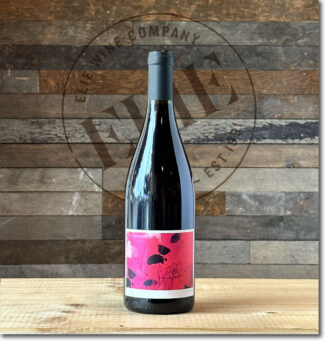 L’Alezan ‘Ostara’, 2022 Ardèche VdF Rouge ($37)
L’Alezan ‘Ostara’, 2022 Ardèche VdF Rouge ($37)
Ostara is a Pagan solar holiday honoring the spring’s warmth, light from the sun, and the awakening of the earth; a fitting name for this blend of two-thirds Grenache and one-third Syrah from the Doux Valley. The Grenache is fermented whole-cluster and the Syrah direct-pressed. The wine shows earthy, smoky, black peppery nuances that offer a savory aspect to the rich blackberry and boysenberry fruit.
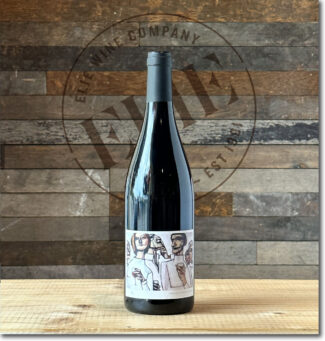 L’Alezan ‘Les Vains’, 2022 Ardèche VdF Rouge ($44)
L’Alezan ‘Les Vains’, 2022 Ardèche VdF Rouge ($44)
The wine is the result of a ten-day maceration of whole cluster Cinsault and Grenache followed by a year’s élevage in foudre, amphora and demi-muid. Cinsault, lacking the structure, color and tannin of Grenache, gives an aromatic lift, offering raspberry coulis scents and an herbaceous undertone to the rich fruity profile and note of garrigue at the finish.
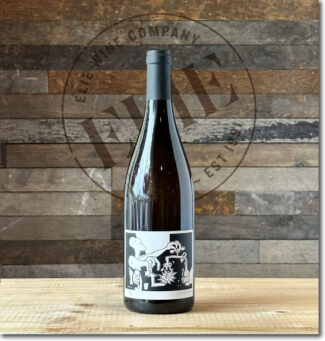 L’Alezan ‘Ho’oponopono’, 2022 Ardèche VdF Blanc ($48)
L’Alezan ‘Ho’oponopono’, 2022 Ardèche VdF Blanc ($48)
Named after a Hawaiian healing mantra that also serves as a hymn for acceptance and resolution, this harmonious blend of Viognier, Marsanne, Roussanne is macerated whole cluster for seven days before aging in a mix of foudre, amphora and stainless-steel tanks. The wine displays Viognier-typical aromatics of nectarine and peach with flowery hints; the mouth is clean and crisp without evidence of oak or malolactic fermentation.
RECENT ARRIVAL
Vaucluse Bounty: Two Reds and One White From Domaine Les Maoù
Les Maoù is owned by Vincent and Aurélie Garreta, part of the new wave of Ventoux winemakers whose approach is natural. They have been certified organic since 2014, but parcels have been farmed organically for over two decades and were certified organic under the previous land owner as well.
These three wines are representative of their approach to the various grapes grown under their careful watch and exuberant technique.
South by Southeast: Experimental Producers Are Leading The Rhône Revolution in Ventoux
Ventoux is a large wine region in the far southeast of the southern Rhône, 25 miles northeast of Avignon and bordering Provence. Covering 51 communes, the vines are planted on the western slopes of Mt. Ventoux, a sort of ‘stray’ Alp removed from the range and towering over the landscape for miles around. Terroir and varieties are typical for Rhône, although noteworthy are the region’s Muscat produced for table grapes, which has its own AOP—Muscat du Ventoux.
Historically overshadowed by its headline-stealing cousins, Châteauneuf-du-Pape and Gigondas, Ventoux was once dominated by cooperatives and garnered a reputation for producing light, insipid and cheap wine. In fact, its name, derived from the iconic peak that lords over the Southern Rhône, was once known less for wine and more for providing a grueling finish to the Tour de France.
It is safe to say that few appellations in the Southern Rhône have undergone such a marvelous transformation over the past 20 years thanks to a small group of visionary and experimental winemakers leading a Rhône revolution, with the wine world finally standing up and taking notice.
These winemakers eschew strict parameters or a ‘classic’ appellation style, and have snapped up relatively inexpensive but high quality vineyard land in the varied mountainous terrain as well as the creative freedom to experiment and truly express themselves through their wines. The increased altitude and temperature variation between night and day—thanks to cooling air currents that descend from Mount Ventoux each evening—has the effect of extending the growing season and allowing the grapes to reach incredible levels of phenolic ripeness. Combined with an incredibly diverse range of microbial rich soils, a handful of up-and-coming growers have pushed the boundaries of what can be created.
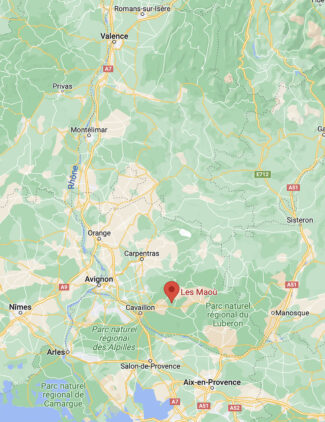
Les Maoù
Ask Vincent and Aurélie Garreta to name their children and the list may include Grenache, Clairette, Carignan, Cabernet Sauvignon, Aubun (a local variety on the verge of extinction), Cinsaut (spelled the ancient way). With this variety of varieties, far beyond the usual suspect, the couple farms 25 acres on the limestone slopes from the Monts de Vaucluse, where alluvial sand and clay form the terroir.

Vincent and Aurélie Garreta, Domaine Les Maoù
Vincent explains their process: “Much of the juice undergoes semi-carbonic maceration and ferments in cement, at which point it is left to age until blended and bottled in the spring. The results are jewels of varying degrees of ruby-red, from the light and bright ‘Entre Chats’ and ‘Au P’tit Bonheur” to the fresh and lively ‘Vaste Programme’ and “L’un Dans L’autre” to the deeper, darker ‘Entre Les Gouttes’ and ‘Hauts Les Coeurs’, all intended to deliver — all sure to deliver ‘un coup de foudre’—a thunderbolt.”
 Les Maoù ‘Entre Les Gouttes’ 2021 Ventoux VdF Rouge ($31)
Les Maoù ‘Entre Les Gouttes’ 2021 Ventoux VdF Rouge ($31)
Literally, ‘Between the Drops’, this exuberant red wine is a blend of late-harvested and semi-carbonically-macerated Carignan (70%) and Aubun (30%), from Vaucluse between the Rhône and Provence. It spends 2-3 months in stainless steel or resin tanks and is not filtered or fined prior to bottling. It is bright red in the glass and also on the palate, showcasing cherry, raspberry and cranberry notes behind licorice, baking spice and a peppery finish.
 Les Maoù ‘Vaste Programme’ 2021 Ventoux VdF Rouge ($33)
Les Maoù ‘Vaste Programme’ 2021 Ventoux VdF Rouge ($33)
Carignan (60%), Grenache (20%), Aubun (20%); the wine undergoes semi-carbonic maceration for eight days followed by 2-3 months in stainless steel or resin tanks. Aubun, as noted above, is a local and quickly disappearing black-skinned red grape that integrates cautious acidity with soft tannins. Blended with Carignan and Grenache, it produces a bright wine bursting with wild floral notes, red berries, ripe plums and white pepper.
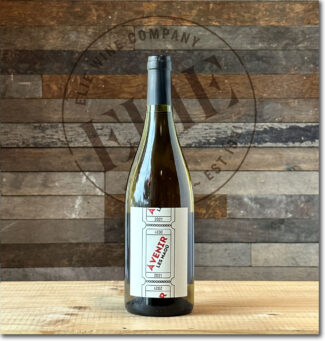 Les Maoù ‘À Venir’ 2021 Ventoux VdF Blanc ($33)
Les Maoù ‘À Venir’ 2021 Ventoux VdF Blanc ($33)
Meaning ‘To The Future’, the wine is 53% Carignan Noir, 47% Clairette Rose; the vines are 30 and 70 years of age respectively. The grapes are fermented together in stainless steel tank and bottled in the spring with 10-15 mg/l of SO2 and no filtration to produce a white wine redolent of apple and lime blossom, with a hint of fennel and verbena on the palate.
Notebook . . .
The Gesture of Natural: Wine in The Raw
In wine, ‘natural’ is a concept before it’s a style. It refers to a philosophy; an attitude. It may involve a regimen of rituals or it may be as simple as a gesture, but the goal, in nearly every case, is the purest expression of fruit that a winemaker, working within a given vineyard, can fashion. Not all ‘natural’ wines are created equal, and some are clearly better than others, but of course, neither is every estate the same, nor every soil type, nor each individual vigneron’s ideology.
The theory is sound: To reveal the most honest nuances in a grape’s nature, especially when reared in a specific environment, the less intervention used, the better. If flaws arise in the final product—off-flavors, rogue, or ‘stuck’ fermentation (when nature takes its course), it may often be laid at the door of inexperience. Natural wine purists often claim that this technique is ancient and that making wine without preservatives is the historical precedent. That’s not entirely true, of course; using sulfites to kill bacteria or errant yeast strains dates to the 8th century BCE. What is fact, however, is that some ‘natural’ wines are wonderful and others are not, and that the most successful arise from an overall organoleptic perspective may be those better called ‘low-intervention’ wine, or ‘raw’ wine—terminology now adopted by many vignerons and sommeliers.
At its most dogmatic and (arguably) most OCD, natural wines come from vineyards not sprayed with pesticides or herbicides, where the grapes are picked by hand and fermented with native yeast; they are fined via gravity and use no additives to preserve or shore up flavor, including sugar and sulfites. Winemakers who prefer to eliminate the very real risk of contaminating an entire harvest may use small amounts of sulfites to preserve and stabilize (10 to 35 parts per million) and in natural wine circles, this is generally considered an acceptable amount, especially if the estate maintains a biodynamic approach to vineyard management.
In all things wine, ‘balance’ is a key to the kingdom; it is a term interchangeable with harmony, and may reference acid, alcohol level, grape sugars and tannin, but also, to a scale in which the long-term health of the product is considered along with the flavors inherent on release. More than just a current radar blip in trendy social capital a naturalistic approach to winemaking is not only more honest, but better for a sustainable environment: It’s a nod to the past and a gesture to the future.
Catch All ‘Vin de France’ (VdF) : Forgoing Appellation Rules
Wines in France are classified into one of three categories: AOP (Appellation d’Origine Protegée, formerly AOC), IGP (formerly Vin de Pays) and Vin de France (VdF). AOP wines are identified only by the names of their appellations, usually without varietal descriptions; the next level, IGP, comes from broader regions, and may be identified by varietal names; and the lowest level has no indication of origin at all.
Vin de France (VdF) is a catch-all. Produced often at high yields, most Vins de France are low-priced, but hidden within them are top wines, pushed out of the appellation system, that can be every bit as good as the best in the AOP. They can be hard to identify, because origins aren’t obvious – many indicate only the names of producer and cuvée – and while they may seem expensive for this lowly category, they can offer remarkable interest. With only a few high-flying Vins de France, this is a small class, but it’s well worth investigating.
- - -
Posted on 2023.10.27 in France, Wine-Aid Packages
Featured Wines
- Notebook: A’Boudt Town
- Saturday Sips Wines
- Saturday Sips Review Club
- The Champagne Society
- Wine-Aid Packages
Wine Regions
Grape Varieties
Aglianico, Albarino, Albarín Blanco, Albarín Tinto, Albillo, Aleatico, Aligote, Arbanne, Aubun, Barbarossa, barbera, Biancu Gentile, bourboulenc, Cabernet Franc, Caino, Caladoc, Calvi, Carcajolu-Neru, Carignan, Chablis, Chardonnay, Chasselas, Cinsault, Clairette, Corvina, Counoise, Dolcetto, Erbamat, Ferrol, Frappato, Friulano, Fromenteau, Gamay, Garnacha, Garnacha Tintorera, Gewurztraminer, Graciano, Grenache, Grenache Blanc, Groppello, Juan Garcia, Lambrusco, Loureira, Macabeo, Macabou, Malbec, Malvasia, Malvasia Nera, Marcelan, Marsanne, Marselan, Marzemino, Mondeuse, Montanaccia, Montònega, Morescola, Morescono, Moscatell, Muscat, Natural, Niellucciu, Parellada, Patrimonio, Pedro Ximénez, Petit Meslier, Petit Verdot, Pineau d'Aunis, Pinot Blanc, Pinot Gris, Pinot Meunier, Pinot Noir, Pouilly Fuisse, Pouilly Loche, Poulsard, Prieto Picudo, Riesling, Rondinella, Rousanne, Roussanne, Sagrantino, Sauvignon Blanc, Savignin, Sciacarellu, Semillon, Souson, Sparkling, Sumoll, Sylvaner, Syrah, Tannat, Tempranillo, Trebbiano, Trebbiano Valtenesi, Treixadura, Trousseau, Ugni Blanc, vaccarèse, Verdicchio, Vermentino, Xarel-loWines & Events by Date
- May 2024
- April 2024
- March 2024
- February 2024
- January 2024
- December 2023
- November 2023
- October 2023
- September 2023
- August 2023
- July 2023
- June 2023
- May 2023
- April 2023
- March 2023
- February 2023
- January 2023
- December 2022
- November 2022
- October 2022
- September 2022
- August 2022
- July 2022
- June 2022
- May 2022
- April 2022
- March 2022
- February 2022
- January 2022
- December 2021
- November 2021
- October 2021
- September 2021
- August 2021
- July 2021
- June 2021
- May 2021
- April 2021
- March 2021
- February 2021
- January 2021
- December 2020
- November 2020
- October 2020
- September 2020
- August 2020
- July 2020
- June 2020
- May 2020
- April 2020
- March 2020
- February 2020
- January 2020
- December 2019
- November 2019
- October 2019
- September 2019
- August 2019
- July 2019
- June 2019
- May 2019
- April 2019
- March 2019
- February 2019
- January 2019
- December 2018
- November 2018
- October 2018
- September 2018
- August 2018
- July 2018
- June 2018
- May 2018
- April 2018
- March 2018
- February 2018
- January 2018
- December 2017
- November 2017
- October 2017
- September 2017
- August 2017
- July 2017
- June 2017
- May 2017
- April 2017
- March 2017
- February 2017
- January 2017
- December 2016
- November 2016
- October 2016
- September 2016
- August 2016
- July 2016
- June 2016
- May 2016
- April 2016
- March 2016
- February 2016
- January 2016
- December 2015
- November 2015
- October 2015
- September 2015
- August 2015
- July 2015
- June 2015
- May 2015
- April 2015
- March 2015
- February 2015
- January 2015
- December 2014
- November 2014
- October 2014
- September 2014
- August 2014
- July 2014
- June 2014
- April 2014
- March 2014
- February 2014
- January 2014
- December 2013
- November 2013
- October 2013
- September 2013
- August 2013
- July 2013
- June 2013
- May 2013
- April 2013
- March 2013
- February 2013
- January 2013
- December 2012
- November 2012
- October 2012
- February 2004
Search



